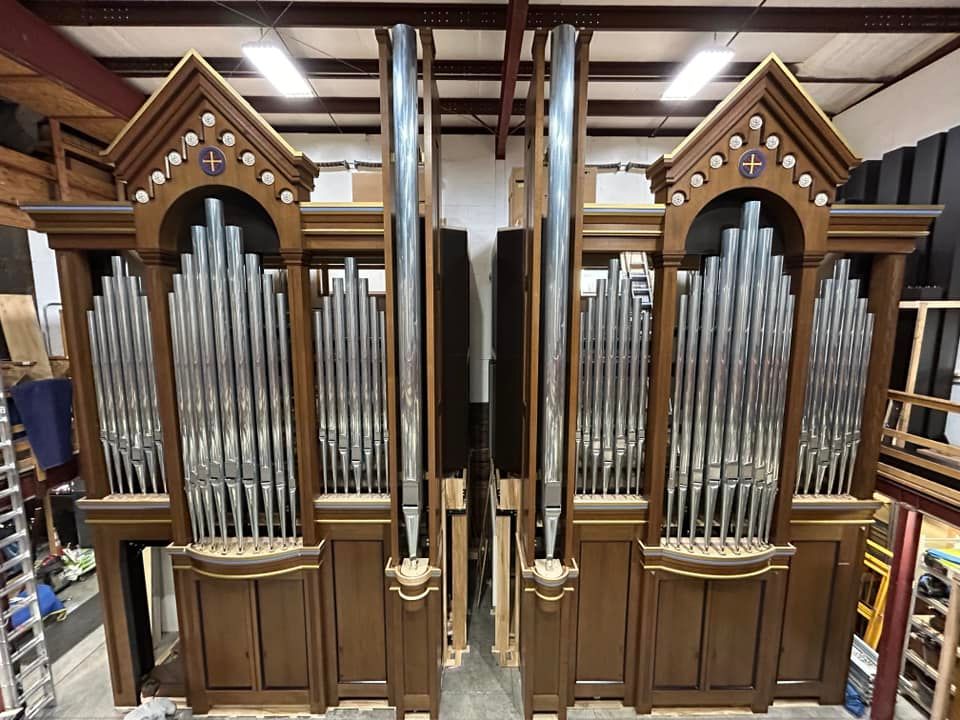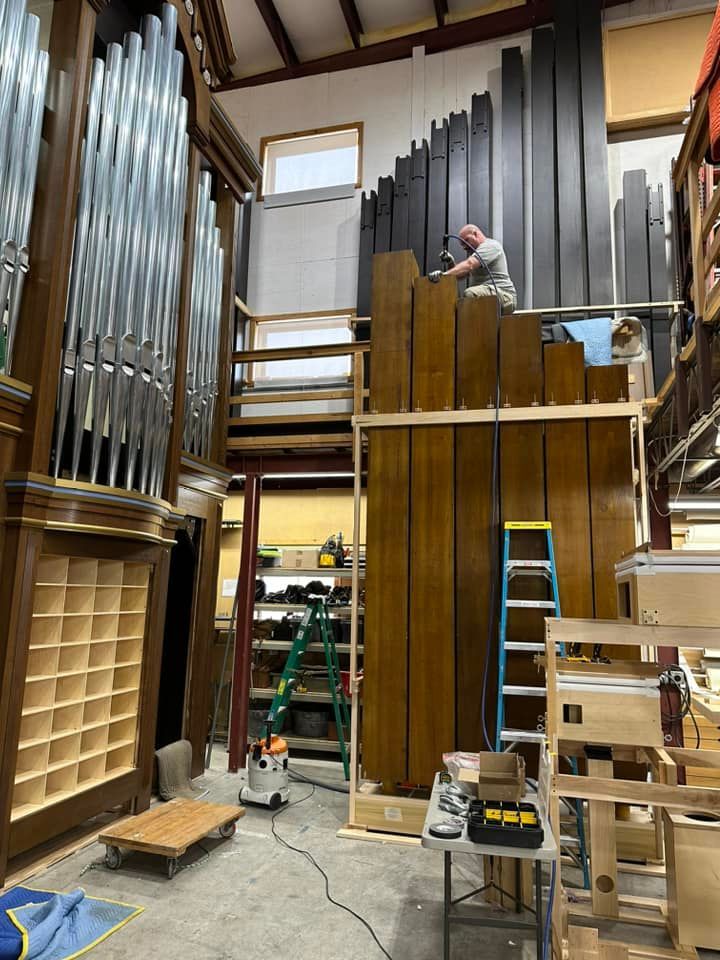New Organ
Upcoming Celebrations for our new organ
Blessing of the Organ
November 6, 2024 at 9:00 am
First Concert
Saturday, February 8, 2025
The arrival of a new Cathedral pipe organ always marks a joyous occasion and a time of great celebration! This is particularly true when the organ has been designed for a grand space, a growing congregation and is intended to encourage active and appropriate expressions of liturgy and music throughout the diocese.
The Cathedral pipe organ constructed by Parsons Pipe Organ Builders of Canandaigua, New York, is now installed and awaiting a few minor tweaks. Several 54’ trailers were required to deliver the organ to Evansville. Once delivered, the process to remove, stage and hoist the organ’s mechanisms, casework and pipes into the balcony, (typically called the gallery), took the better part of three weeks. Although there were only two weekends where Masses were held in a different location, during the first weeks of the installation, there were parts of the organ that remain strategically placed throughout the Cathedral. It’s often thought that pipe organs are built and assembled in a shop and simply lifted into place upon their arrival. While it’s true that once built, pipe organs are assembled, tested and made to play while at the builder’s workshop, prior to leaving the workshop, the entire organ is completely taken apart and expertly crated before being loaded into the delivery trailers.
After being brought inside the Cathedral and staged, organ components were lifted into the gallery in the order in which they will be assembled. This is a fascinating process! Initially, crates containing components and pipes were placed on the floor as well as being laid across the tops of well-protected pews. In fact, many of the pipes were placed in the pews themselves. As the installation proceeded, parts of the organ were carried or lifted from ground level up to the gallery until all the structure and working parts of the organ were assembled and made ready to receive pipes. The whole process involved thousands of components, all of which were labeled and stamped to show exactly where they belong. In addition to the structure and working components, the casework that surrounds the functioning apparatus and pipes and serves to reflect sound into the room was put into place. Casework is typically the part of the organ that people actually see. Casework for the Cathedral organ was designed by Peter Geise at Parsons to reflect the architecture of the Cathedral and to include the cross of St. Benedict. The goal in designing casework is to ensure that the organ becomes an integral part of the architectural features of the Cathedral and appears as though it was part and parcel of the original 1927 building.
The Cathedral organ is actually the combination of two organs with each organ having its own function. The organs can be played separately but can also be combined when the pews are full or when specific sounds are required. The main organ, located in the balcony at the back of the church is called the Gallery organ. The Gallery organ contains 62 ranks, (sets of pipes), for a total of 3,780 pipes. The Gallery organ is used to encourage and support congregational singing, to accompany choirs, cantors, vocal soloists and instrumentalists. The secondary organ located at the front of the nave is called the Nave organ. While the Gallery organ is surrounded by its own case that incorporates the stained-glass windows and measures 59’ wide by 13’ deep and 33’ high at the peak of the central arch, the Nave organ is housed in what was a closed-off space towards the front of the Cathedral. The space was originally thought to have been reserved for a nun’s gallery. Although the opening and archway leading into the room were bricked up before the parish opened, the room itself was already built and for the most part, has remained vacant. The room is located above the sacristy and behind the wall that stands perpendicular to the statue of the Holy Mother. In preparation for housing the Nave organ, an opening was made between the nave and the vacant room to allow sound from the organ to enter the Cathedral. The opening is appropriately shielded with decorative casework and pipes. The Nave organ contains 8 ranks, (sets of pipes), for a total of 560 pipes. The organ will be used to support smaller gatherings situated at the front of the Cathedral and to accompany clergy and cantors. Altogether, the Cathedral organ will contain 70 ranks and 4,370 pipes!
Did you know that pipe organs produce sound in the same way that airplanes are made to fly? Or that in an organ such as the one being built for the Cathedral, there are pipes that measure from one inch to 32 feet in length?
Parsons Pipe Organ Builders – Canandaigua, NY







